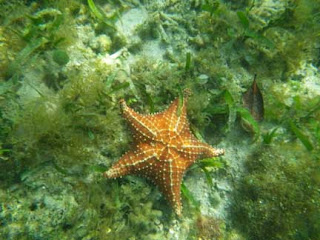The Author, up a tree in the mangrove fringe.
Sampling dead twigs from the higher branches.
After a long hot day climbing through the “mangrove jungle gym” we had a chance to jump into the lagoon and see the underwater communities that live on the seagrass bottom and on the mangrove roots. Seagrass beds in the tropics are populated by an amazing combination of plant and animal families, from turtle grass and numerous types of green and red (both hard and soft) algae, to corals, fan worms, sea cucumbers, sponges, jellyfish and echinoderms (urchins and sea stars). One photo may include so many organisms that you won’t be able to find them all in one viewing. Look at the photos in this post to see how many life forms you can differentiate. Identification requires good field guides.
Cushion sea star among algae, coral, turtlegrass, worms and sponges.
Most fascinating are the prop roots of the Red Mangrove (Rhizophora mangle) which extend down into the seagrass beds. These roots contain a specific ecosystem that includes mangrove oysters, many colorful stinging sponges, corals, anemones, algae, tunicates and small encrusting organisms.
Rhizophora prop roots hanging into seagrass beds, covered with attached marine life, particularly sponges and oysters.
Sponge covered root with large fan worm.
Mangrove oysters.
Fire coral (Millepora sp.) encrusting a prop root.
Fire sponge - pretty, but don't touch it. It earns its name in burning pain from stinging cells.
The same goes for the fire coral.
Mangrove prop roots are an essential development habitat for many reef fishes. The juvenile fish live in the protective roots to avoid predation until they are large enough to migrate to the reef as adults. In some areas (e.g. parts of Belize) where mangroves have been destroyed to clear areas for shrimp farming or resort construction, economically and culturally important fish populations have gone extinct locally.
Mangroves are very important as coastal protection from erosion during major storms, as a filter for excessive surface runoff (to trap contaminants before the runoff enters the sea) and as a vast ecosystem for diverse and numerous large and cryptic life forms. Preservation of mangroves is more important to the economies of their home countries than selling and cutting them for commercial purposes.












No comments:
Post a Comment